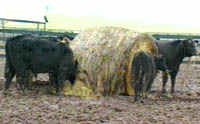Water Is Main Concern for Winter Livestock Management
Water Is Main Concern for Winter Livestock Management

Winter can be a rough weather time for Kentuckians. Fortunately, most of us can stay inside where it's warm and not have to worry about having food and water. Livestock, on the other hand, don't have it so easy.
"The absolute worst weather for any kind of livestock is freezing rain," Monty Chappell, University of Kentucky College of Agriculture sheep specialist, said. "Snow is not a problem if it's dry. Cold weather is not a problem if the sun is shining. It's all a problem if the wind is blowing."
The biggest thing for producers to remember is that livestock need water, or they won't eat. With freezing temperatures, ponds will freeze. Donna Amaral-Phillips, UK dairy specialist, warns that breaking a pond once or twice a day may not be enough.
Bob Coleman, UK horse specialist said that even if ponds are broken, the water may be too cold for animals to drink. He suggests supplying water that has been warmed "up to at least 37 degrees Fahrenheit" to ensure adequate intake.
"The problem with ponds is that they freeze from the outside in," John Johns, UK beef specialist, said. "So we're talking about livestock going out on the ice to get to the water and going swimming. If that happens they won't survive."
After the need for water is realized, producers have to remember that livestock require more energy to make it through the winter months. More energy means additional high-quality forages and grains. It's a common myth that grain rations are hotter rations. High-quality forage rations actually provide more heat for livestock. It may be tougher to feed forage this year. This year, both forage quality and quantity may be a problem. Producers should take advantage of forage testing to better understand what they actually have.
"You have to realize an animal's need for nutrients goes up as the temperature drops, especially if they get wet and then it gets cold," Amaral-Phillips said. "They won't gain as well unless you up their (feed) intake. ‘Newborns' need more feed energy, since body stores at birth are low. This can be accomplished with dairy calves by feeding higher-fat milk replacers."
In general, Chappell recommends having a supply of feed available to get livestock through times when the roads may be closed due to snow, ice, etc. Livestock in isolated areas, away from the center of the operation, need to have at least a week's supply of feed available.
Amaral-Phillips stressed the importance of good, dry bedding. Animals who are kept dry have a better chance of staying comfortable and alive than those who stay wet during cold spells. Extra attentions should be given to protecting ‘newborns' from drafts.
Another important aspect of winter livestock management is knowing the body condition of your animals.
"Producers need to know the of body condition of their animals," Coleman said. "Horses in less than moderate condition will find it much harder to stay warm, because they won't have the insulation. Their energy requirements will be higher. Producers should start trying to increase body score in October before severe winter weather hits. One body score will change the feed requirements dramatically."
Chappell added it is important to get the internal parasite level as low as possible, because that is a way to reduce stress. A lot of animals may have bad body condition because of internal parasites.
When caring for livestock in times of weather stress, remember that animals have a much better tolerance for cold than humans do. For example, the comfort range for cattle is somewhere between 40 and 70 degrees Fahrenheit. Horses have a wider range, from about 10 to 80 degrees Fahrenheit. Hogs housed in confinement usually are fine unless there is a power outage and that requires auxiliary power until electricity service is restored.
"Confining the animals completely is not the answer either," Chappell said. "If you have a 20-degree day and the wind is not blowing and the sun is shining, most animals ought to be outside. There are fewer problems with ventilation and associated barn humidity. I guess the rule of thumb is if you open the door, and they want to go outside, they ought to be outside; if they take one look and go back inside, they should stay inside."
With proper management, livestock producers should sail through the winter months with relatively no problems. Prevention and attentiveness to each situation are key elements to a successful winter on the farm.
" It's really quite simple," Coleman said. "If you have water readily available, a good source of feed, and shelter that protects from wind and moisture, you'll be okay."
